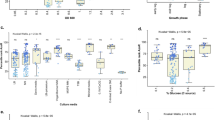Abstract
The transfer of the IncP-7 carbazole degradative plasmid pCAR1 from Pseudomonas putida SM1443 (derived from strain KT2440) into bacteria of river water samples was monitored using a reporter gene encoding red fluorescent protein (RFP). The number of transconjugants drastically increased in the presence of carbazole, and most appeared to belong to the genus Pseudomonas. The results suggest that the presence of carbazole benefits the appearance of transconjugants belonging to the genus Pseudomonas. Intriguingly, we also detected the transfer of pCAR1 into non-Pseudomonas, Stenotrophomonas-like bacteria.

Similar content being viewed by others
References
Christensen BB, Sternberg S, Andersen JB, Eberl L, Møller S, Givskov M, Molin S (1998) Establishment of new genetic traits in a microbial biofilm community. Appl Environ Microbiol 64:2247–2255
De Gelder L, Vandecasteele FP, Brown CJ, Forney LJ, Top EM (2005) Plasmid donor affects host range of promiscuous IncP-1beta plasmid pB10 in an activated-sludge microbial community. Appl Environ Microbiol 71:5309–5317
Dejonghe W, Goris J, El Fantroussi S, Hofte M, De Vos P, Verstraete Top EM (2000) Effect of dissemination of 2,4-dichlorophenoxyacetic acid (2,4-D) degradation plasmids on 2,4-D degradation and on bacterial community structure in two different soil horizons. Appl Environ Microbiol 66:3297–3304
Haagensen JAJ, Hansen SK, Johansen T, Molin S (2002) In situ detection of horizontal transfer of mobile genetic elements. FEMS Microbiol Ecol 42:261–268
Heuer H, Krsek M, Baker P, Smalla K, Wellington EMH (1997) Analysis of actinomycete communities by specific amplification of genes encoding 16S rRNA and gel-electrophoretic separation in denaturing gradients. Appl Environ Microbiol 63:3233–3241
Izmalkova TY, Sazonova OI, Sokolov SL, Kosheleva IA, Boronin AM (2005) The P-7 incompatibility group plasmids responsible for biodegradation of naphthalene and salicylate in fluorescent Pseudomonads. Microbiology (Pleiades publish) 74:342–348
Li W, Shi J, Wang X, Han Y, Tong W, Ma L, Liu B, Cai B (2004) Complete nucleotide sequence and organization of the naphthalene catabolic plasmid pND6-1 from Pseudomonas sp. strain ND6. Gene 336:231–240
Maeda K, Nojiri H, Shintani M, Yoshida T, Habe H, Omori T (2003) Complete nucleotide sequence of carbazole/dioxin-degrading plasmid pCAR1 in Pseudomonas resinovorans strain CA10 indicates its mosaicity and the presence of large catabolic transposon Tn4676. J Mol Biol 326:21–33
Nancharaiah YV, Wattiau P, Wuertz S, Bathe S, Mohan V, Wilderer PA, Hausner M (2003) Dual labeling of Pseudomonas putida with fluorescent proteins for in situ monitoring of conjugal transfer of the TOL plasmid. Appl Environ Microbiol 69:4846–4852
Nojiri H, Shintani M, Omori T (2004) Divergence of mobile genetic elements involved in the distribution of xenobiotic-catabolic capacity. Appl Microbiol Biotechnol 64:154–174
Sambrook J, Russell DW (2001) Molecular cloning: a laboratory manual, 3rd edn. Cold Spring Harbor Laboratory Press, Cold Spring Harbor, NY
Shintani M, Habe H, Tsuda M, Omori T, Yamane H, Nojiri H (2005a) Recipient range of IncP-7 conjugative plasmid pCAR2 from Pseudomonas putida HS01 is broader than from other Pseudomonas strains. Biotechnol Lett 27:1847–1853
Shintani M, Yano H, Habe H, Omori T, Yamane H, Tsuda M, Nojiri H (2006) Characterization of the replication, maintenance, and transfer features of the IncP-7 plasmid pCAR1, which carries genes involved in carbazole and dioxin degradation. Appl Environ Microbiol 72:3206–3216
Shintani M, Yoshida T, Habe H, Omori T, Nojiri H (2005b) Large plasmid pCAR2 and class II transposon Tn4676 are functional mobile genetic elements to distribute the carbazole/dioxin-degradative car gene cluster in different bacteria. Appl Microbiol Biotechnol 67:370–382
Simon R, Priefer U, Pühler A (1983) A broad host range mobilization system for in vivo genetic engineering: transposon mutagenesis in Gram negative bacteria. Biotechnology 1:784–791
Sørensen JS, Bailey M, Hansen LH, Kroer N, Wuertz S (2005) Studying plasmid horizontal transfer in situ: a critical review. Nat Rev Microbiol 3:700–710
Urata M, Uchimura H, Noguchi H, Sakaguchi T, Takemura T, Eto K, Habe H, Omori T, Yamane H, Nojiri H (2006) Plasmid pCAR3 contains multiple gene sets involved in the conversion of carbazole to anthranilate. Appl Environ Microbiol 72:3198–3205
Yano H, Garruto CE, Sota M, Ohtsubo Y, Nagata Y, Zylstra GJ, Williams PA, Tsuda M (2007) Complete sequence determination combined with analysis of transposition/site-specific recombination events to explain genetic organization of IncP-7 TOL plasmid pWW53 and related mobile genetic elements. J Mol Biol 369:11–26
Acknowledgements
We are most grateful to Professor Dr. Molin Sølen of the Technical University of Denmark and associate professor Dr. Eva Top of the University of Idaho for providing pSM1833 and P. putida SM1443. This study was supported by the Program for Promotion of Basic Research Activities for Innovative Biosciences (PROBRAIN) in Japan and a Grant-in-Aid (Hazardous Chemicals) from the Ministry of Agriculture, Forestry, and Fisheries of Japan (HC-07-2325-2).
Author information
Authors and Affiliations
Corresponding author
Rights and permissions
About this article
Cite this article
Shintani, M., Fukushima, N., Tezuka, M. et al. Conjugative transfer of the IncP-7 carbazole degradative plasmid, pCAR1, in river water samples. Biotechnol Lett 30, 117–122 (2008). https://doi.org/10.1007/s10529-007-9519-y
Received:
Revised:
Accepted:
Published:
Issue Date:
DOI: https://doi.org/10.1007/s10529-007-9519-y




